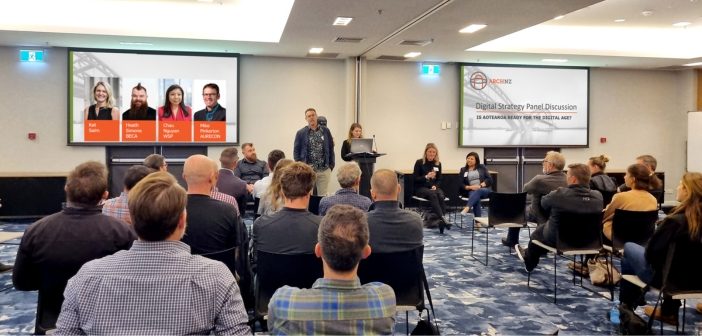
Is New Zealand ready for the digital age?
This was the theme of the panel discussion that closed out the 2024 ARCH NZ conference. Autonomy & Reality Capture Hub NZ (ARCH NZ) is a user group for professionals working in the AEC industry in New Zealand. The inaugural annual user conference was held in Auckland on 22 March 2024.
When speaking to digital specialists in our industry, it’s usually only a matter of time before someone references the McKinsey Report “Imaging Construction’s Digital Future” from 2016, in which it was reported that large construction projects are typically 80% over budget and take 20% longer than expected. The report focused on how technological adoption could help claim back efficiency in some of these projects and also noted that the construction industry globally is one of the slowest to adopt digital strategies, despite the scope for wide benefits in efficiency. The 2022 updated report states that we have not made much progress and still have far to go for digital technology adoption in construction.
A panel of experts convened to explore this question, focusing on digital trends within the architectural, engineering and construction (AEC) industry in New Zealand. The discussion aimed to be a frank conversation around the panel’s own experiences, including digital tools, processes, technologies, digital twin platforms and strategy.
In this article, we summarise some of the key themes and takeaways from the discussion.
What does “Going Digital” mean to you?
A recurrent theme was the ambiguity surrounding the term ‘digital’ and the process of ‘digitalisation’. One of the panelists quipped “Does plugging in my PC count?” to a ripple of laughter from the audience. This light hearted start to the conversation perfectly highlighted the ambiguity of the term! The word “digital” encompasses so many broad and different aspects that one panelist has banned it completely from their digital strategy meetings.
Despite being catch-all phrases, ‘digital’ and ‘digitalisation’ in relation to AEC are relevant terms for the current trend and future direction of the industry. The overarching aim of digitalisation is to improve current workflows and make them more efficient. We live in a world where the deliverables were due yesterday. Technology is seen as a tool to help speed up efficiency. There are lots of different ways to go digital, but one is digital twin platforms. Another contentious term “digital twins” enable better coordination through the planning to construction phases.
In the US, it has been reported that digital twins saved the Minnesota Department of Transportation more that $15 million USD during the conversion of 2.8 miles of TH 169 into an expanded freeway.
Similarly, in Australia the West Connex in New South Wales could save taxpayers $800 million.
It’s clear that going digital can lead to better management of infrastructure assets, but also takes the value of digitalisation beyond a bottom line of profit. For instance, the time we get back from going digital can be used to innovate and improve elsewhere.
What are the barriers to innovation?
There are several barriers and challenges to this digitalisation process. Foremost, is getting buy-in from the client. Followed by getting buy-in from your company. Company goals which are aimed at breaking down silos and supporting innovation are especially important in the fiercely competitive New Zealand market.
Educating your clients to get buy-in
Client buy-in is an obvious barrier to the digitalisation process, because of the element of risk, some clients are reluctant to adapt to digital methods despite the benefits that practitioners know about, but perhaps clients don’t. The panel discussed this and generally agreed that client reluctance is largely because clients don’t know what they don’t know; therefore client education is also a key factor.
Clients come to us for our expertise, so it’s important to spend time investing in taking clients with us on the journey. The strength of the client relationship drives the appetite for innovation, there is a need to become a ‘trusted advisors to your clients’ and educate them along the way. This also helps manage client expectations, there was some discussion on client RFPs sometimes not being in line with what is achievable, and the need for discussion and honest feedback.
Ultimately, to go digital takes a lot of personal responsibility by the individual within an organisation, who will drive the digitalisation process and advocate for change. This requires the knowledge and confidence that using digital methods will result in significant savings in time and budget compared to traditional methods.
Company goals that support innovation
While individual accountability plays a crucial role in initiating the digital processes, it is imperative for the company to offer robust support for a digital first strategy. Establishing a supportive framework for innovation is paramount, particularly within the unique landscape of New Zealand, where the AEC industry operates with distinct dynamics compared to other regions. Some panelists highlighted differences between their international experiences and the challenges of working in New Zealand, where although there is competition due to the smaller market scale, there is also collaboration and the sense of a community within the industry.
The panel discussed how the competitive market can lead to the prioritisation of billable hours over innovation and learning, which can hinder the advancement of digital methods. Clients’ escalating demands for speed exacerbate the strain on the already under-resourced AEC sector.
There is a need for a strategic pause amidst the frenzy of deadlines, the need to build in breathing space to a project so that the potential efficiencies that digital methods offer can be assessed. If company KPI’s are extremely tight this can inadvertently stifle innovation by limiting this breathing space and the room to innovate.
It’s a complex landscape with multifaceted pressures. Organisation leaders who aims to foster an environment conducive to innovation, recognise that change often arises from necessity rather than preference. Company-wide policies that encourage learning serve as ‘risk mitigation strategies’ and those that had experienced workplaces that foster learning and growth had benefited greatly from those environments, both personally and on delivering projects for their clients.
Ultimately, companies that fail to embrace and support innovation risk being left behind when the ‘disrupters’ come to play in this evolving landscape. We have seen these disruptors evidenced in other industries, for examples Sail GP and Nascar.
Are you concerned about governance and ethics?
Throughout the panel discussions concerns arose over the governance and ethics of digital data management were raised. Much of this digital data goes into online digital twin environments, but how do we manage data privacy and security of these online environments?
Digital twins inherently entail the collection and storage of vast amounts of personal and sensitive information. Questions arise regarding who owns this data, how it is stored, security and who has access to it. The panel stressed the importance of governance and ethics, noting instances where concerns over data privacy had led to digital twin vetoes in some Australian states. This underscores the significance of metadata.
There seems to be growing concerns over the potential for misuse or manipulation of digital twin data and the arising ethical dilemmas. There is already large volumes of publicly accessible data accessible via the internet that could be open to misuse e.g. Google Earth and other locational data platforms.
As digital twins become more integrated into daily life and critical infrastructure, addressing these ethical considerations is key to ensuring they are developed and utilised in a responsible and ethical manner. Is this something that ultimately will be the responsibility of the industry to regulate and ensure the proper usage of these digital twins?
Looking ahead, possibilities seem boundless, with the consensus being that “imagination is the limit”. Future prospects include leveraging AI to expedite data creation and management, although this technology isn’t quite there yet, it is improving all the time and has the potential to impact significantly.
Thank you to the panel
This panel discussion was hosted by Bruce Robinson from Global Survey, with four experts in the field to discuss their views and experiences.

Dr. Kat Salm, Consultant – UrbanKind |

Heath Simone, Senior Associate, Digital Delivery Systems Specialist – Beca |

Chau Nguyen, Director, Strategic Advisory (Digital) – WSP |

Mike Pinkerton, Technical Director, Geospatial – Aurecon |
Thank you to all the panelists for their animated discussion and insights, as well as all the attendees of the conference!
Find out more about joining the user group – Autonomy & Reality Capture Hub NZ (ARCH NZ)
SHARE THIS ARTICLE


